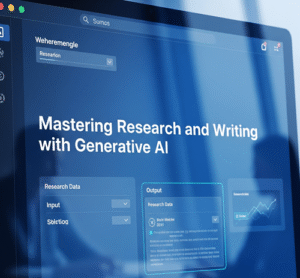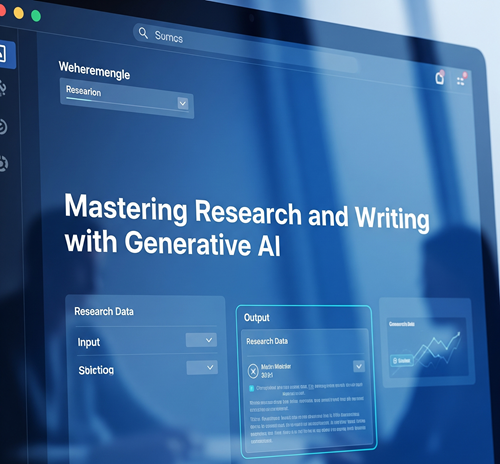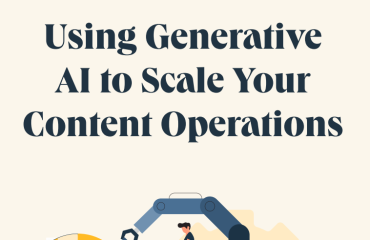
Harnessing the power of Generative AI, particularly tools like ChatGPT, marks a pivotal shift in how to approach research and writing. This isn’t about replacing human intellect but augmenting it, providing an unprecedented opportunity to elevate the way we work.
The AI Revolution: A New Era of Thinking
Automation has streamlined “doing” – repetitive tasks have been handled by machines and robots for centuries. However, the advent of AI, especially Large Language Models, introduces the automation of “thinking.” This development can be viewed as either a threat or a tremendous opportunity. The key lies in understanding how to effectively collaborate with AI.
The approach to working with generative AI can be broken down into three core phases: preparation, interaction, and continuation.
Preparation: Defining Your Desired Output
Before you even begin to interact with an AI, preparation is paramount. You need to have a crystal-clear vision of the exact outcome you’re aiming for. This foresight allows you to formulate the right questions and, crucially, craft an effective prompt.
Think of a prompt as your comprehensive brief to the AI. Unlike simple, short sentences, effective prompts are often paragraphs long. They need context and a precise definition of the desired output. Just as you wouldn’t expect a human to produce excellent work with minimal instruction, AI requires detailed guidance. The more information you provide, the better the results.
Interaction: Guiding the Conversation
Once your prompt is ready, the interaction begins. This is your ongoing conversation with the AI. Your role is to direct and refine this dialogue, steering it toward the desired response. It’s a dynamic back-and-forth, much like a collaborative discussion with a colleague.
Continuation: The Human Touch
The final stage, continuation, is where your human judgment, expertise, and abilities truly shine. The AI’s output should never be considered a finished product. It’s your responsibility to challenge, refine, and improve upon what the AI provides, adding the nuanced human elements that AI, despite its sophistication, cannot yet fully replicate. This isn’t about AI doing less work for you, but rather enabling you to achieve more and better by working smarter.
The Art of Prompt Engineering: The CREATE Framework
To unlock the full potential of AI, mastering prompt writing is essential. The CREATE framework offers a simple yet powerful mnemonic to guide you:
- C – Character: Tell ChatGPT what role you want it to play (e.g., “You are a talented copywriter with 20 years of experience…”). This helps the AI draw on relevant and high-quality information.
- R – Request: Be specific about what you want the AI to do, providing ample context and useful information. Avoid vague instructions.
- E – Examples: (Optional but highly recommended) Provide examples of desired headlines, tone of voice, or style. ChatGPT excels at learning from these and replicating similar outputs.
- A – Adjustments: These are refinements you make when the initial output isn’t quite right. Use phrases like “Don’t use bullet points” or “Use subheads.”
- T – Type of Output: Specify the desired format (e.g., “Deliver your response as a 500-word article with a headline and a conclusion”). This can include articles, bullet points, tables, poems, or scripts.
- E – Extras: These are powerful additions that can significantly impact the outcome:
- “Ignore everything before this prompt”: Useful when starting a new line of inquiry.
- “Ask me questions before you answer”: Ensures the AI gathers all necessary information before generating a response.
- “Explain your thinking”: Allows you to verify the AI’s reasoning, much like “showing your work” in mathematics.
While effective prompts may take a little more time to craft, the increased effort dramatically improves the quality of the results.
Working with AI Responses: Collaboration, Not Consumption
It’s crucial to distinguish AI from a traditional search engine. A search engine returns results, and you’re done. With AI, it’s a conversational journey of refinement and iteration. See the AI as a collaborator, not a servant. Your input directly defines the quality of the output.
Provide feedback, praise good responses, and ask the AI to expand on promising ideas. If you get an idea during the conversation, share it and ask the AI to explore the concept further.
Always remember: your humanity is vital. Apply your unique abilities to transform adequate AI output into something truly excellent. Additionally, always double-check the accuracy of the output. AI can sometimes generate plausible but entirely fabricated information. Finally, be transparent about your use of AI. There’s no shame in leveraging these powerful tools; in fact, it makes you smarter and more efficient.
Practical Applications of AI in Research and Writing
Generative AI offers a myriad of practical applications to enhance your research and writing workflow:
- Summarising Complex Information: AI can quickly condense lengthy texts into concise paragraphs, bullet points, and single-sentence summaries, helping you extract key concepts efficiently.
- Gaining Multiple Perspectives: Overcome your own biases by prompting AI to list various perspectives on a topic, considering different audiences and their motivations. This broadens your research and fosters more comprehensive ideas.
- Accessing Expert Advice: Imagine tapping into the wisdom of the world’s smartest individuals. AI can simulate subject matter experts, providing advice, strategic insights, and step-by-step instructions on various topics, from business consultancy to scientific thinking.
- Creating User Personas: For audience understanding, AI can generate lists of possible audiences for a product, including their profession, age, and needs. You can then use this information to create detailed user personas, complete with biographies, goals, pain points, and motivations.
- Discovering Strategic Models: AI can suggest relevant strategic models for specific business problems, explain how to use them, and even provide examples of how they might be filled in. This helps align thinking and reach effective solutions.
- Finding Facts and Statistics: While AI may not always provide direct sources, it can suggest powerful search engine queries to help you uncover unique facts and statistics. If you find a large document, you can then use AI to summarise it.
- Analysing and Improving Writing Style: AI can analyse existing copy for tone of voice across various dimensions (e.g., funny vs. serious, formal vs. casual). More impressively, it can rewrite your own copy to meet specific stylistic requirements, removing jargon, correcting grammar, and varying sentence length for improved readability and engagement.
- Generating Headline and Article Ideas: Break free from creative ruts by using AI to generate clickable headlines and fresh article ideas, drawing inspiration from successful existing content.
- Outlining Content: AI can help you outline your content by asking clarifying questions and then presenting key points in a structured format, ensuring you have all your “ingredients” ready before you begin writing, thus maintaining your flow and productivity.










